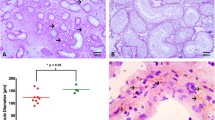Summary
Testes from five male-to-female transsexuals removed during sex-reversal surgery after administration of estrogens were studied histologically and with immunoperoxidase procedures to locate estrogen receptors (ER) and related antigens. Atrophy of the seminiferous tubules was observed in all cases; its degree, and a marked decrease in Leydig cells, correlated with low plasma gonadotropin levels (rather than with the duration of treatment). In all cases, the rete testis appeared hyperplastic and the other components (efferent ductules, epididymus) well preserved. The efferent ductules proved to be the only structure where ER can be located by the ER-ICA procedure, whereas staining for the p 29 ER-associated antigen is strongly positive both here and in the rete testis. The immunocytochemical data, in parallel with the observed biological effects, indicate that the rete testis and the efferent ductules and, to a minor degree, the epididymus and Leydig cells are the main direct targets of estrogens in the human testis.
Similar content being viewed by others
References
Byskov AG (1978) The anatomy and ultrastructure of the rete system in the fetal mouse ovary. Biol Rep 19:720–735
Cano A, Coffer A, Adatia R, Millis R, Rubens R, King RJB (1986) Histochemical studies on oestrogen receptor-related protein in human breast tumors. Cancer Res 46:6475–6480
Carlon N, Stahl A (1973) Les premiers stades dy développement des gonadés chez l'homme et les vertébrés supérieurs. Pathol Biol 21:903–914
Coffer AI, Spiller GM, Lewis KM, King RJB (1985) Immunoradiometric studies with monoclonal antibody against a component related to human estrogen receptor. Cancer Res 45:3694–3698
Depue RH, Pike MC, Henderson BE (1983) Estrogen exposure during gestation and risk of testicular cancer. J Natl Cancer Inst 71:1151–1155
Gooren L (1986) The neuroendocrine response of luteinizinghormone to estrogen administration in heterosexual, homosexual, and transsexual subjects. J Clin Endocrinol Metabol 63:583–588
Hatakeyama S (1965) A study on the interstitial cells of the human testis. Especially on their fine-structural pathology. Acta Pathol Jap 15:155–197
Hsu SM, Raine L, Fanger H (1981) Use of avidin-biotin peroxidase complex (ABC) in immunoperoxidase techniques: a comparison between ABC and unlabeled antibody (PAP) procedures. J Histochem Cytochem 29:577–580
King RJB, Coffer AL, Gilbert J, Lewis K, Nash R, Millis R, Raju S, Taylor RW (1985) Histological studies with a monoclonal antibody raised against a partially purified soluble estradiol receptor preparation from human myometrium. Cancer Res 45:5728–5733
King WJ, Green GL (1984) Monoclonal antibodies localize estrogen receptor in the nuclei of target cells. Nature 307:745–747
Murphy JB, Emmott RC, Hicks LL, Walsh PC (1980) Estrogen receptors in the human prostate, seminal vesicle, epididymis, testis, and genital skin: a marker for estrogen-responsive tissues? J Clin Endocrinol Metabol 50:938–948
Newbold RR, Bullock BC, McLachlan JA (1985) Lesions of the rete testis in mice exposed prenatally to diethylstilbestrol. Cancer Res 45:5145–5150
Oshima H, Sarada T, Ochiai OK, Tamoaki B (1974) Effects of synthetic estrogen upon steroid bioconversation in vitro in testis of patients with prostatic cancer. Invest Urol 12:43–49
Pietribiasi F, Gugliotta P, Racca S, Di Carlo F, Bussolati G (1986) A combined histological, immunocytochemical and biochemical approach in the evaluation of estrogen receptors in breast carcinomas. Int J Biol Markers 1:9–14
Puchtler H, Waldrop ES, Meloan SM, Terry MS, Conner HM (1970) Methacarn (methanol-carnoy) fixation. Histochemie 21:97
Rodriguez-Rigau L, Tcholakian RK, Smith K, Steinberger E (1977) Effect of in vivo estrogen administration on in vitro steroid bioconversation in human testis. In: Troen P, Nankin HR (eds) The testis in normal and infertile men. Raven Press, New York, pp 457–468
Schoen SS, Rush BF Jr (1959) Adenocarcinoma of the rete testis. J Urol 82:356–363
Stumpf WE (1969) Nuclear concentration of3H-estradiol in target tissues. Dry-mount auto radiography of vagina, oviduct, ovary, testis, mammary tumor, liver and adrenal. Endocrinology 85:31–37
Tarakawa N, Huseby RA, Fang SM, Samuels LT (1982) Quantitative changes in estrogen receptor produced by chronic DES treatment of two mouse strains differing in susceptibility to Leydig cell tumor induction. J Steroid Biochem 16:643–652
Yoshitomi K, Morii S (1984) Benign and malignant epithelial tumors of the rete testis in mice. Vet Pathol 21:300–303
Author information
Authors and Affiliations
Rights and permissions
About this article
Cite this article
Sapino, A., Pagani, A., Godano, A. et al. Effects of estrogens on the testis of transsexuals: A pathological and immunocytochemical study. Vichows Archiv A Pathol Anat 411, 409–414 (1987). https://doi.org/10.1007/BF00735221
Accepted:
Issue Date:
DOI: https://doi.org/10.1007/BF00735221




